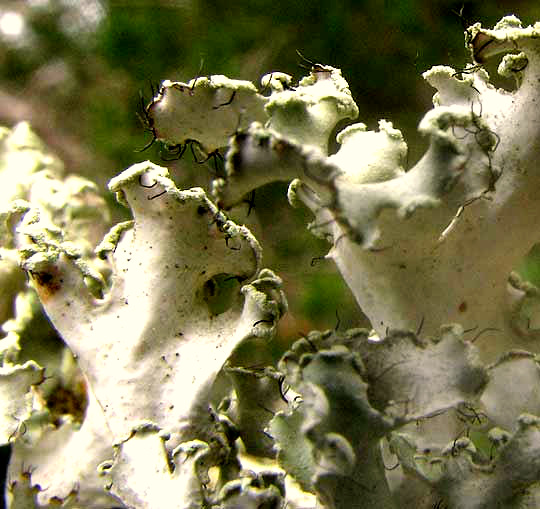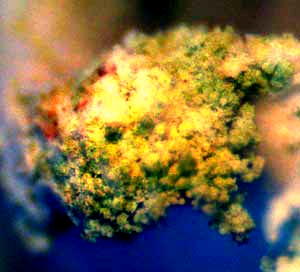Excerpts from Jim Conrad's
Naturalist Newsletter

from the March 23, 2014 Newsletter issued from the Frio Canyon Nature Education Center in the valley of the Dry Frio River in northern Uvalde County, southwestern Texas, on the southern border of the Edwards Plateau; elevation ~1750m (~5750 ft); N29.62°, W99.86°; USA
POWDERED RUFFLE LICHEN
The Texas Live Oak's low-hanging limb was so heavily cloaked with leafy lichens that the stem itself couldn't be seen. However, as I scanned the lichens, it was the usual species turning up again and again... until one struck me as slightly different from all the rest. For one thing, its thallus margins were exceptionally ruffly-frilly, as you can see above. A close-up showing better the thickened thallus margins is shown below:

Even much closer, a detail of one spot along a thickened margin shows that the thickness consists of massed, powdery-looking granules, shown below:

The swollen, powdery-looking rims bear "soralia," which in turn are composed of "soredia," which are composed of small groups of algal cells surrounded by fungal filaments. When dust-like soredia break from their soralia and land in an environment appropriate for the species, they grow into new lichens. Soredia are not formed by any sexual process, so the resulting lichen will have the same genetic makeup as the parent.
Besides the thickened rims, another distinction of this little colony was that none of its thalli bear the spore-producing, cup-like apothecia normally seen on such leafy lichens borne on twigs. Also, notice the black, hair-like structures along the thallus margins, which are cilia. Some very similar lichen species completely lack such cilia, or the cilia may be much longer, so these black cilia provide a good field mark. The function of cilia isn't known, but it's been suggested that during times of high humidity, as when it's foggy, they provide places on which water may condense -- water the lichen can use.
Our present lichen belongs to a large genus whose leafy, or "foliose," members mostly inhabit tree bark or acidic rock. It's the genus Parmotrema. Another Parmotrema species, which is somewhat similar, commonly occurs on tree limbs in our area, the Perforated Ruffle Lichen, which you can compare with our present one at https://www.backyardnature.net/n/x/p-r-lich.htm.
Note that that species also bears cilia, but lacks the swollen, soralia-occupied margins, and its thalli often bear spore-producing cups, or apothecia.
Within Parmotrema at least three species look like our lichen. The LichenPortal.Org website informs us that "... P. hypoleucinum, P. hypotropum and P. louisianae are all morphological nearly identical. The species have not yet been investigated from a molecular perspective." Our lichen appears to be one of them.
All three of those look-alike species have been observed in Texas, and both P. hypotropum and P. hypoleucinum occur in the area of the southern Edwards Plateau, though P hypotropum seems to occur closer to us in the western region, and pictures of that species, on the average, match ours the best.
Therefore, I'm filing this page under PARMOTREMA HYPOTROPUM, knowing that eventually a specialist will find it and be glad to know what our local representatives of the group look like, and correct me if needed. The only common name I can find for it, rarely used, is Powdered Ruffle Lichen, and that seems good enough.
By the way, the Powdered Ruffle Lichen does very rarely produce apothecia that issue sexually produced spores. This is one of those occasional species encountered in nature that mostly depends on asexual reproduction, but practices just enough sex to modestly keep the evolutionary process going.